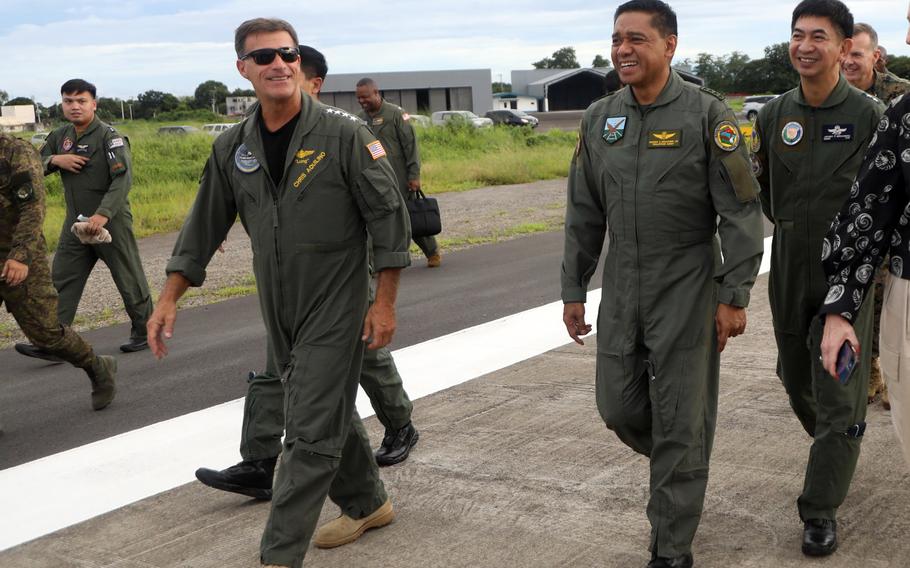
Adm. John Aquilino, left, head of U.S. Indo-Pacific Command, and the Philippines' military chief, Lt. Gen. Romeo Brawner, recently visited three sites being developed to support U.S. forces in the Philippines. (U.S. Indo-Pacific Command)
The U.S. military is seeking access to more bases in the Philippines, the head of U.S. Indo-Pacific Command told reporters during a press conference Thursday.
U.S. forces already have access to nine sites in the country, including four announced in February, under the Enhanced Defense Cooperation Agreement.
The U.S. is looking for more locations, Adm. John Aquilino said in the Philippines alongside that country’s armed forces chief of staff, Lt. Gen. Romeo Brawner, according to a Friday report by NHK.
“General Brawner and I made recommendations to our senior leaders for the consideration of additional sites, but there’s still work to do there,” the INDOPACOM commander said.
INDOPACOM posts Friday on X, formerly known as Twitter, show Aquilino and Brawner visiting three sites being developed to support U.S. forces in the northern Philippines: Cagayan North International Airport, also known as Lal-lo; Camilo Osias Naval Base; and Cesar Basa Air Base.
The main purpose of the base-sharing agreement is training and disaster response, not for responses to regional security threats, Brawner said in the NHK report.
However, recent clashes between Chinese and Philippines coast guard vessels in disputed areas of the South China Sea and an exercise this week by the Chinese aircraft carrier Shandong carrier off the Philippines’ northern coast are driving Washington and Manila closer, according to Leland Bettis, director of the Pacific Center for Island Security on Guam.
The threat posed by Chinese missiles to large operating bases has spurred efforts by U.S. forces to develop skills needed to fight from many smaller locations throughout the region.
“All the U.S. services are looking for more ‘places’ to operate from in the first (and second) island chain to support their distributed and dispersed operating concepts,” Bettis said in an email Friday. “The Philippines is no doubt looking to bolster more U.S. operational support for enforcement of their national claims” in the South China Sea.
A candidate for another shared base is in the Batanes islands, where a U.S. team recently assessed a port less than 125 miles from Taiwan, Jay Batongbacal, director of the University of the Philippines’ Institute for Maritime Affairs and Law of the Sea, said Friday in an X message to Stars and Stripes.
The U.S. is looking to enhance its ability to respond to contingencies in the South China Sea and involving Taiwan, according to Ralph Cossa, president emeritus of the Pacific Forum think tank in Hawaii.
Rumors suggest the Navy seeks to regain access to Subic Bay and a return by the Air Force to nearby Clark Air Base can’t be ruled out, he said by email Friday.
Subic and Clark formed America’s largest overseas military presence before both were damaged in the 1991 eruption of Mount Pinatubo and soon after returned to the Philippines.
“A US return to either Clark or Subic would be a real attention-getter both positively (as a message to China) and negatively (as a rallying cry for anti-US elements),” Cossa wrote.
Seeking access to smaller facilities still sends a message to China but would likely draw less attention and complaints, he added.
Discussions over access to smaller Philippine bases is consistent with the direction the two allies have taken, Ian Chong, an associate professor of political science at the National University of Singapore, said by email Friday.
“As for candidates for bases, I think the U.S. has for some time been working with the Philippines to develop a network of dispersed, smaller bases rather than massive ones like a Clark or a Subic,” he said.